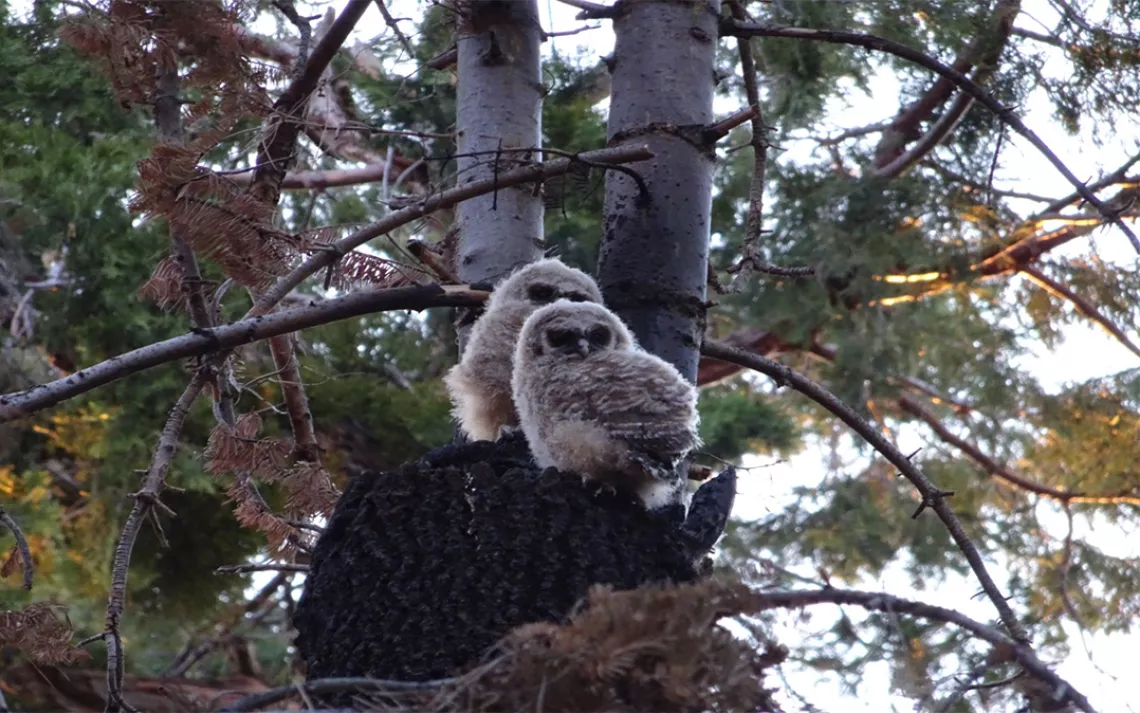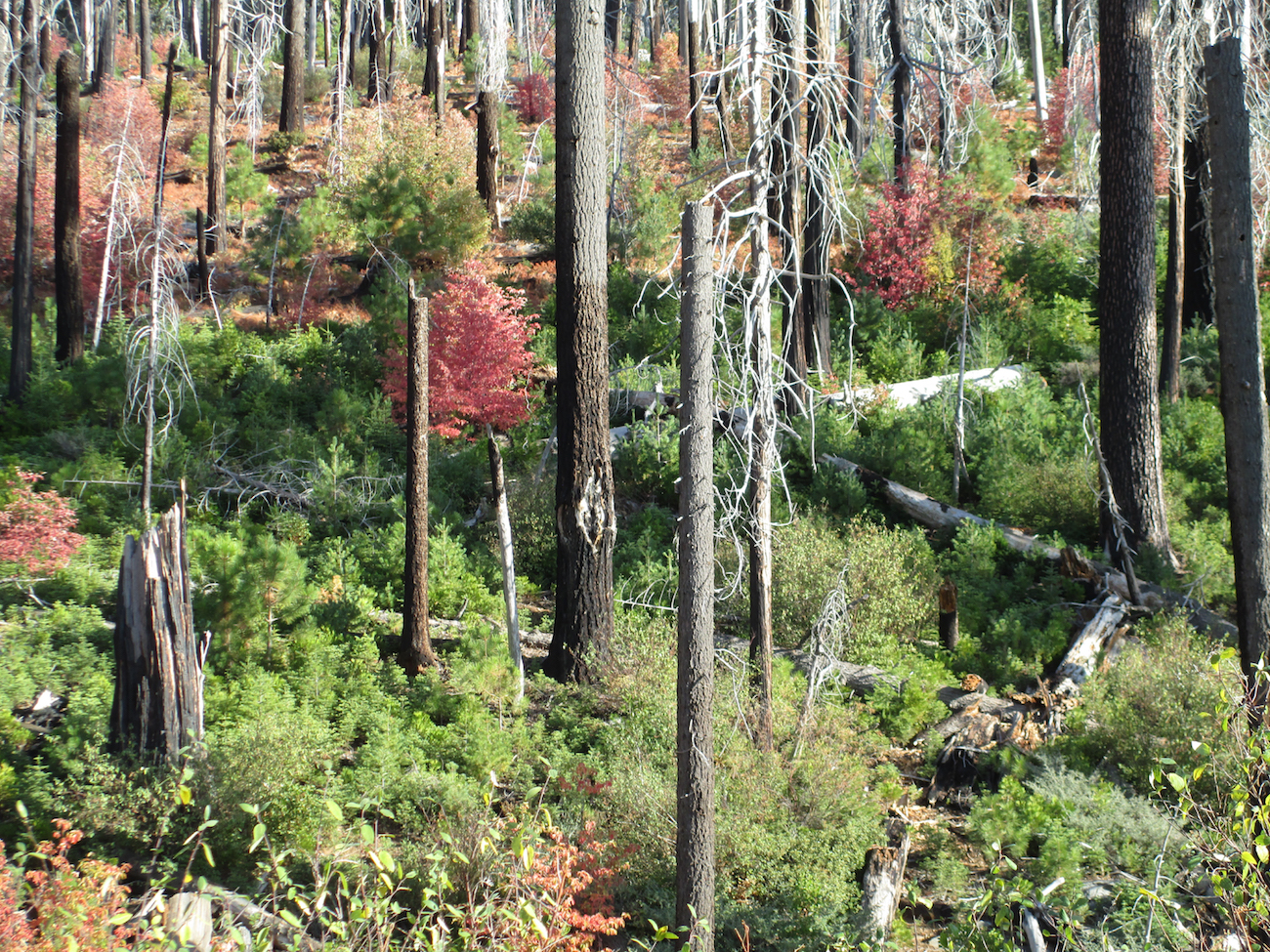Don’t Believe the Hype: Burned Forests Are Often Full of Life
A slew of scientific studies show that wildland fire—including large fires—benefits spotted owls

California spotted owls nesting during the Lake Fire of 2015 in San Bernardino National Forest, Southern California. This pair of owls relocated their territory from the unburned forest and set up their nest on the edge of a large, high-intensity fire patch. They produced two chicks, which successfully fledged. | Photo courtesy of Rachel Fazio
Bumping along a rutted logging road deep in the Sierra Nevada, I hit the brakes hard as I came around a bend. A logging crew was cutting down a patch of fire-killed trees, or “snags,” next to the road. It was 2002, and I was monitoring the effects of a large post-fire timber sale in the Star Fire, which occurred a year earlier.
“You know, I can understand why you don’t want us to cut down that stand farther down the road, where the trees are alive and green,” the foreman of the logging crew told me, pointing to a lightly burned stand of live trees to which I was heading to check on a pair of California spotted owls. “But this stand here,” he said, sweeping his gaze across the fire-killed trees in the area where they were logging. “It’s been destroyed by fire. What wildlife species are going to use this? What harm could possibly come from cutting this down?”
It was an excellent question—and I didn’t have a good answer. I left the logging crew behind to complete my forest monitoring work, but the question stayed with me. I became curious, and in the following days and weeks I spent long hours in research libraries, tracking down everything I could find on the subject. What I discovered surprised me: Study after study was finding that “snag forest habitat,” created by patches of high-intensity fire in mature forest, was comparable to unburned old forest in terms of native biodiversity and wildlife abundance. My interest grew, and those days and weeks of research turned into years and years of research as I pursued a doctorate in forest ecology.
When I started my doctoral research, at the top of my list of species of concern was the spotted owl, a reclusive forest raptor known to depend on dense, old forest for nesting and roosting. Back in 2002, people assumed that forest fires were harmful to the owls, especially in high-intensity fire patches where most or all of the trees are killed. But though the spotted owl’s preference for nesting in unburned to moderately burned forests was well established, some of us thought a piece of the puzzle was missing. Other researchers and I wondered, “Where do the owls hunt for their food?”
We soon began to uncover some answers. Monica Bond and colleagues published a study that examined all three subspecies of the owl—northern spotted owls, California spotted owls, and Mexican spotted owls—and concluded that there was no reduction in territory occupancy due to fire and, interestingly, discovered higher levels of reproduction in burned forests than in unburned stands. This was intriguing, since higher reproduction generally means better and more abundant food.
In the subsequent years, numerous other studies backed up those initial findings. A 2009 study using radio-tracking devices strapped to the backs of California spotted owls in the 151,000-acre McNally Fire in the Sequoia National Forest found the owls preferentially selected snag forest habitat for hunting. The researchers later confirmed this was because the small mammal prey base was especially good for the owls in the snag forests. A 2012 study by Derek Lee and colleagues looked at numerous very large, mixed-intensity forest fires in the Sierra Nevada and found no reduction in spotted owl territory occupancy, except where snag forest hunting grounds had been removed through post-fire logging.

Snag forest habitat, naturally regenerating after high-intensity fire and characterized by an abundance of snags, downed logs, natural regeneration of conifers, oaks, dogwoods, and native shrubs (12 years after the Star Fire of 2001; Eldorado National Forest, Sierra Nevada). | Photo by Chad Hanson
Unfortunately, federal officials at the U.S. Forest Service still haven’t gotten the message—or they’ve tuned it out. Although the overwhelming majority of scientific studies have found neutral or positive effects of large fires on spotted owls, logging remains common after fires in our national forests and other federal public lands. Under a federal law called the Salvage Sale Fund Act, the Forest Service and the Bureau of Land Management keep 100 percent of the revenue from selling public timber to private logging companies after fires, creating a powerful incentive for logging.
The continuation of logging in post-burn areas is especially frustrating given the additional research showing that such logging can have severe negative impacts on spotted owls. For example, after the 257,000-acre Rim Fire of 2013 on the edges of Yosemite National Park, the Stanislaus National Forest authorized a giant post-fire logging timber sale on national forest lands; the Forest Service claimed the fire would have already extirpated most of the owls anyway. But shortly thereafter, Lee and Bond found record-high spotted owl occupancy levels at one year post fire, before logging began.
When post-fire logging occurs, the prime hunting habitat is removed or damaged, and the local extinction of owls often results, as was the case in several post-fire logged territories in the Rim Fire. Similar local extinction of some territories occurred after post-fire logging in the large King Fire of 2014 in the Sierra Nevada. Elsewhere in the King Fire, where post-fire logging had not occurred, spotted owl occupancy increased slightly after the fire, and the owls actively foraged in unlogged snag forest patches.
Scientists who study spotted owls and wildland fire call this relationship between the nesting/roosting habitat and nearby snag forest habitat the “bed and breakfast effect.” The juxtaposition of the two habitat types creates a highly beneficial mix of conditions under which the owls tend to thrive, providing them with both shelter and food.
Not only does the Forest Service continue proposing and implementing post-fire logging projects in spotted owl habitat, the agency is also proposing a large increase in “mechanical thinning” logging projects. The Forest Service promotes post-fire logging and mechanical thinning under the deceptive guises of “restoration” and “fuel reduction.” This has consequences not only for spotted owls, but also for the many rare and declining wildlife species that depend upon snag forest habitat for nesting or foraging. In September 2015, more than 200 scientists signed a letter to Congress protesting the Forest Service’s post-fire logging, and noted that snag forest habitat is “quite simply some of the best wildlife habitat in forests” and “it is the least protected of all forest habitat types, and is often as rare, or rarer, than old-growth forest.”
I often think back to that 2002 conversation with the logging crew. As it happens, my colleagues and I were successful in stopping the Forest Service from logging the stands of live trees in the Star Fire area, including the spotted owl nesting area that I was monitoring. But the adjacent snag forest habitat was cut, turned into sterile stumpfields. As this misunderstood and underappreciated habitat was lost, so, too, was the pair of owls that I had spent hundreds of hours trying to protect.
As a society, we need to move past the fear, misunderstanding, and cynical economic opportunism that characterized forest management and wildland fire policy in the 20th century and develop a new, 21st-century understanding about fire in our forests based upon the current science. The spotted owl, and many other forest species, are depending on our willingness to do so.
 The Magazine of The Sierra Club
The Magazine of The Sierra Club



